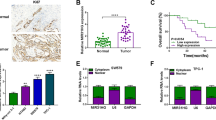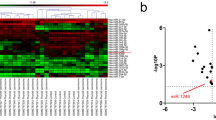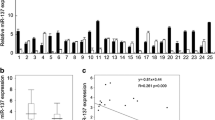Abstract
Thyroid cancer, as one of the most common cancers in many countries, has attracted increasing attention, but its pathogenesis is still unclear. This research explored the effects of miR-144-3p and GABRB2 on thyroid cancer cells and the underlying mechanism. Gene expression data was obtained from the GEO database to analyze differential expression of mRNAs and miRNAs in patients with thyroid cancer. CCK-8, transwell, scratch, and flow cytometry assays were performed to detect cell proliferation, invasion, migration, and apoptosis, respectively. Dual-luciferase reporters were used to detect the binding of miR-144-3p to GABRB2. GABRB2 was highly expressed and miR-144-3p was underexpressed in thyroid cancer. In thyroid cancer cells, inhibiting GABRB2 or upregulating miR-144-3p reduced proliferation, invasion, and migration and increased apoptotic rates; GABRB2 overexpression or miR-144-3p inhibition brought about the opposite results. miR-144-3p targeted GABRB2 and negatively regulated its expression. PI3K/AKT activation was reduced in thyroid cancer cells overexpressing miR-144-3p. GABRB2 overexpression partially mitigated the tumor-suppressive effect of miR-144-3p overexpression. In conclusion, miR-144-3p targets GABRB2 to inhibit PI3K/AKT activation, thereby inhibiting the progression of thyroid cancer in vitro.






Similar content being viewed by others
Data Availability
The datasets used or analyzed during the current study are available from the corresponding author on reasonable request.
References
Laha, D., Nilubol, N., & Boufraqech, M. (2020). New therapies for advanced thyroid cancer. Frontiers in Endocrinology, 11, 82.
Nabhan, F., Dedhia, P. H., & Ringel, M. D. (2021). Thyroid cancer, recent advances in diagnosis and therapy. International Journal of Cancer, 149(5), 984–992.
Pizzato, M., Li, M., Vignat, J., Laversanne, M., Singh, D., La Vecchia, C., & Vaccarella, S. (2022). The epidemiological landscape of thyroid cancer worldwide: GLOBOCAN estimates for incidence and mortality rates in 2020. The Lancet Diabetes & Endocrinology, 10(4), 264–272.
Boucai, L., Zafereo, M., & Cabanillas, M. E. (2024). Thyroid cancer: A review. JAMA, 331(5), 425–435.
Araque, K. A., Gubbi, S., & Klubo-Gwiezdzinska, J. (2020). Updates on the management of thyroid cancer. Hormone and Metabolic Research, 52(8), 562–577.
Maillard, P. Y., Baer, S., Schaefer, E., Desnous, B., Villeneuve, N., Lepine, A., Fabre, A., Lacoste, C., El Chehadeh, S., Piton, A., Porter, L. F., Perriard, C., Warde, M. A., Spitz, M. A., Laugel, V., Lesca, G., Putoux, A., Ville, D., Mignot, C., Heron, D., Nabbout, R., Barcia, G., Rio, M., Roubertie, A., Meyer, P., Paquis-Flucklinger, V., Patat, O., Lefranc, J., Gerard, M., Epigen, C., de Bellescize, J., Villard, L., De Saint Martin, A., & Milh, M. (2022). Molecular and clinical descriptions of patients with GABA(A) receptor gene variants (GABRA1, GABRB2, GABRB3, GABRG2): A cohort study, review of literature, and genotype-phenotype correlation. Epilepsia, 63(10), 2519–2533.
Belotti, Y., Tolomeo, S., Yu, R., Lim, W. T., & Lim, C. T. (2022) Prognostic neurotransmitter receptors genes are associated with immune response, inflammation and cancer hallmarks in brain tumors. Cancers, 14(10), 2544.
Campos-Parra, A. D., Perez-Quintanilla, M., Martinez-Gutierrez, A. D., Perez-Montiel, D., Coronel-Martinez, J., Millan-Catalan, O., De Leon, D. C., & Perez-Plasencia, C. (2022). Molecular differences between squamous cell carcinoma and adenocarcinoma cervical cancer subtypes: potential prognostic biomarkers. Current Oncology, 29(7), 4689–4702.
Petrini, I., Cecchini, R. L., Mascaro, M., Ponzoni, I., & Carballido, J. A. (2023) Papillary thyroid carcinoma: A thorough bioinformatic analysis of gene expression and clinical data. Genes, 14(6), 1250.
Jin, Y., Jin, W., Zheng, Z., Chen, E., Wang, Q., Wang, Y., Wang, O., & Zhang, X. (2017). GABRB2 plays an important role in the lymph node metastasis of papillary thyroid cancer. Biochemical and Biophysical Research Communications, 492(3), 323–330.
Kargutkar, N., Hariharan, P., & Nadkarni, A. (2023). Dynamic interplay of microRNA in diseases and therapeutic. Clinical Genetics, 103(3), 268–276.
Ho, P. T. B., Clark, I. M., & Le, L. T. T. (2022). MicroRNA-based diagnosis and therapy. International Journal of Molecular Sciences, 23(13), 7167.
Cao, S., Yin, Y., Hu, H., Hong, S., He, W., Lv, W., Liu, R., Li, Y., Yu, S., & Xiao, H. (2023). CircGLIS3 inhibits thyroid cancer invasion and metastasis through miR-146b-3p/AIF1L axis. Cellular Oncology, 46(6), 1777–1789.
Dou, X. L., Xia, F. D., & Li, X. Y. (2023). Circ_0003747 promotes thyroid cancer progression by sponging miR-338-3p to upregulate PLCD3 expression. Epigenetics, 18(1), 2210339.
Guo, K., Qian, K., Shi, Y., Sun, T., & Wang, Z. (2021). LncRNA-MIAT promotes thyroid cancer progression and function as ceRNA to target EZH2 by sponging miR-150-5p. Cell Death & Disease, 12(12), 1097.
Xiong, H., Yu, H., Jia, G., Yu, J., Su, Y., Zhang, J., & Zhou, J. (2021). circZFR regulates thyroid cancer progression by the miR-16/MAPK1 axis. Environmental Toxicology, 36(11), 2236–2244.
Jiang, M., Jike, Y., Liu, K., Gan, F., Zhang, K., Xie, M., Zhang, J., Chen, C., Zou, X., Jiang, X., Dai, Y., Chen, W., Qiu, Y., & Bo, Z. (2023). Exosome-mediated miR-144-3p promotes ferroptosis to inhibit osteosarcoma proliferation, migration, and invasion through regulating ZEB1. Molecular Cancer, 22(1), 113.
Fang, G., Zhang, C., Liu, Z., Peng, Z., Tang, M., & Xue, Q. (2022). MiR-144-3p inhibits the proliferation and metastasis of lung cancer A549 cells via targeting HGF. Journal of Cardiothoracic Surgery, 17(1), 117.
Li, M., Liu, Y., Jiang, X., Hang, Y., Wang, H., Liu, H., Chen, Z., & Xiao, Y. (2021). Inhibition of miR-144-3p exacerbates non-small cell lung cancer progression by targeting CEP55. Acta Biochimica et Biophysica Sinica, 53(10), 1398–1407.
Lu, Y., Zhang, B., Wang, B., Wu, D., Wang, C., Gao, Y., Liang, W., Xi, H., Wang, X., & Chen, L. (2021). MiR-144-3p inhibits gastric cancer progression and stemness via directly targeting GLI2 involved in hedgehog pathway. Journal of Translational Medicine, 19(1), 432.
Liu, J., Chou, Z., Li, C., Huang, K., Wang, X., Li, X., Han, C., Al-Danakh, A., Li, X., & Song, X. (2022). ZBTB7A, a miR-144-3p targeted gene, accelerates bladder cancer progression via downregulating HIC1 expression. Cancer Cell International, 22(1), 179.
Yi, D., Zhang, D., Zeng, Z., Zhang, S., Li, M., & Zhang, Y. (2022). MicroRNA-144-3p represses the growth and EMT of thyroid cancer via the E2F2/TNIK axis in cells and male BALB/c nude mice. Endocrinology, 163(7), bqac071.
Burja, B., Kuret, T., Janko, T., Topalovic, D., Zivkovic, L., Mrak-Poljsak, K., Spremo-Potparevic, B., Zigon, P., Distler, O., Cucnik, S., Sodin-Semrl, S., Lakota, K., & Frank-Bertoncelj, M. (2019). Olive leaf extract attenuates inflammatory activation and DNA damage in human arterial endothelial cells. Frontiers in Cardiovascular Medicine, 6, 56.
Jiang, Q., Guan, Y., Zheng, J., & Lu, H. (2023). TBK1 promotes thyroid cancer progress by activating the PI3K/Akt/mTOR signaling pathway. Immunity Inflammation Disease, 11(3), e796.
Fagin, J. A., & Nikiforov, Y. E. (2023). Progress in thyroid cancer genomics: A 40-year journey. Thyroid, 33(11), 1271–1286.
Sun, N., Zhang, L., Zhang, C., & Yuan, Y. (2020). miR-144-3p inhibits cell proliferation of colorectal cancer cells by targeting BCL6 via inhibition of Wnt/beta-catenin signaling. Cellular & Molecular Biology Letters, 25, 19.
An, C., Hu, Z., Li, Y., Zhao, P., Liu, R., Zhang, Q., Zhu, P., Li, Y., & Wang, Y. (2022). LINC00662 enhances cell progression and stemness in breast cancer by MiR-144-3p/SOX2 axis. Cancer Cell International, 22(1), 184.
Gao, F., Han, J., Jia, L., He, J., Wang, Y., & Chen, M. (2024). Circ_0001982 aggravates breast cancer development through the circ_0001982-miR-144-3p-GSE1 axis. Journal of Biochemical and Molecular Toxicology, 38(1), e23565.
Li, Y., Hong, X., Zhai, J., Liu, Y., Li, R., Wang, X., Zhang, Y., & Lv, Q. (2023). Novel circular RNA circ-0002727 regulates miR-144-3p/KIF14 pathway to promote lung adenocarcinoma progression. Frontiers in Cell and Developmental Biology, 11, 1249174.
Liu, S. W., Yang, P., Li, F. N., Dou, R. G., Liu, J. X., & Liu, G. J. (2022). LncRNA B4GALT1-AS1 promotes non-small cell lung cancer cell growth via increasing ZEB1 level by sponging miR-144-3p. Translational Cancer Research, 11(3), 538–547.
Yuan, H. M., Pu, X. F., Wu, H., & Wu, C. (2023). ENTPD1-AS1-miR-144-3p-mediated high expression of COL5A2 correlates with poor prognosis and macrophage infiltration in gastric cancer. World Journal of Gastrointestinal Oncology, 15(7), 1182–1199.
Zhang, Y., Xie, W., Zheng, W., Qian, X., & Deng, C. (2024). Exosome-mediated circGMPS facilitates the development of gastric cancer cells through miR-144-3p/PUM1. Cytotechnology, 76(1), 53–68.
Yuan, D., Guo, T., Qian, H., Ge, H., Zhao, Y., Huang, A., Wang, X., Cao, X., Zhu, D., He, C., & Yu, H. (2022). Icariside II suppresses the tumorigenesis and development of ovarian cancer by regulating miR-144-3p/IGF2R axis. Drug Development Research, 83(6), 1383–1393.
Cui, Z., Wang, Q., Deng, M. H., & Han, Q. L. (2022). LncRNA HCG11 promotes 5-FU resistance of colon cancer cells through reprogramming glucose metabolism by targeting the miR-144-3p-PDK4 axis. Cancer Biomarkers, 34(1), 41–53.
Gao, Z. Y., Liu, H., & Zhang, Z. (2021). miR-144-3p increases radiosensibility of gastric cancer cells by targeting inhibition of ZEB1. Clinical and Translational Oncology, 23(3), 491–500.
Wang, B., Xu, L., Zhang, J., Cheng, X., Xu, Q., Wang, J., & Mao, F. (2020). LncRNA NORAD accelerates the progression and doxorubicin resistance of neuroblastoma through up-regulating HDAC8 via sponging miR-144-3p. Biomedicine & Pharmacotherapy, 129, 110268.
Wang, P., Yang, Z., Ye, T., Shao, F., Li, J., Sun, N., & He, J. (2020). lncTUG1/miR-144-3p affect the radiosensitivity of esophageal squamous cell carcinoma by competitively regulating c-MET. Journal of Experimental & Clinical Cancer Research, 39(1), 7.
Liu, F., Zhang, J., Qin, L., Yang, Z., Xiong, J., Zhang, Y., Li, R., Li, S., Wang, H., Yu, B., Zhao, W., Wang, W., Li, Z., & Liu, J. (2018). Circular RNA EIF6 (Hsa_circ_0060060) sponges miR-144-3p to promote the cisplatin-resistance of human thyroid carcinoma cells by autophagy regulation. Aging, 10(12), 3806–3820.
Barki, M., & Xue, H. (2022). GABRB2, a key player in neuropsychiatric disorders and beyond. Gene, 809, 146021.
Wang, Q. X., Chen, E. D., Cai, Y. F., Li, Q., Jin, Y. X., Jin, W. X., Wang, Y. H., Zheng, Z. C., Xue, L., Wang, O. C., & Zhang, X. H. (2016). A panel of four genes accurately differentiates benign from malignant thyroid nodules. Journal of Experimental & Clinical Cancer Research, 35(1), 169.
Prete, A., Borges de Souza, P., Censi, S., Muzza, M., Nucci, N., & Sponziello, M. (2020). Update on Fundamental Mechanisms of Thyroid Cancer. Frontiers in Endocrinology, 11, 102.
Acknowledgements
Thanks for all the contributors.
Funding
This research was funded by the grant from Hainan Provincial Natural Science Foundation of China (Grant No. 823MS152).
Author information
Authors and Affiliations
Contributions
QY and XC conceived the ideas; designed the experiments. XC; DXC; DD; ZT; JCG and WD performed the experiments. XC; DXC; DD; ZT and JCG analyzed the data. QY provided critical materials. ZT; JCG and WD wrote the manuscript. QY supervised the study. All the authors have read and approved the final version for publication.
Corresponding author
Ethics declarations
Conflict of interest
The authors declare no competing interests.
Additional information
Publisher’s note Springer Nature remains neutral with regard to jurisdictional claims in published maps and institutional affiliations.
Rights and permissions
Springer Nature or its licensor (e.g. a society or other partner) holds exclusive rights to this article under a publishing agreement with the author(s) or other rightsholder(s); author self-archiving of the accepted manuscript version of this article is solely governed by the terms of such publishing agreement and applicable law.
About this article
Cite this article
Xiu, C., Deng, X., Deng, D. et al. miR-144-3p Targets GABRB2 to Suppress Thyroid Cancer Progression In Vitro. Cell Biochem Biophys 82, 3585–3595 (2024). https://doi.org/10.1007/s12013-024-01446-y
Accepted:
Published:
Issue Date:
DOI: https://doi.org/10.1007/s12013-024-01446-y




